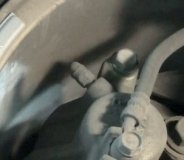Hi and thanks for using 2CarPros.
From past experience, I have found that their top of the line brakes can sometimes be exactly what you described, too thick. What I suggest is to read through these directions and the link and confirm the shoes are properly installed as well as adjusted the entire way down to the smallest diameter they can be. If the drum still doesn't fit, remove the shoes and compare them to the design and size of the old ones. If the backing plate is the same size and design, return the shoes and request new ones. Again, I have experienced this, but never with the mid to lower grade parts.
_________________________________
https://www.2carpros.com/articles/how-to-replace-rear-brake-shoes-and-drums
________________________________
Also, make sure the parking brake is totally off. It may need adjusted down. Make sure it is properly installed and not sticking. Here are the directions specific to your vehicle for removal and install. Make sure you didn't miss anything. All attached pictures correlate with these directions.
_______________________________
PROCEDURES
REMOVAL
1. INSPECT SHOE LINING THICKNESS
Remove the inspection hole plug, and check the shoe lining thickness through the hole.
If less than minimum, replace the shoes.
Minimum thickness: 1.0 mm (0.039 inch)
2. REMOVE REAR WHEEL
3. RELEASE PARKING BRAKE LEVER
4. REMOVE BRAKE DRUM
HINT: If the brake drum cannot be removed easily, do the following steps.
a. Remove the inspection hole plug and insert a screwdriver through the hole in the backing plate.
b. Place the end of a screw driver against the surface of the adjusting latch, and move it in the direction "A".
5. REMOVE FRONT SHOE
a. Remove the front shoe.
1. Using SST, remove the 2 return springs and anchor spring.
SST 09703-30010
2. Using SST, remove the cup, shoe hold-down spring and pin.
SST 09718-00010
3. Remove the front shoe and strut.
4. Remove the 2 C-washers.
5. Remove the automatic adjusting lever, automatic adjusting lever spring and automatic adjusting latch.
6. REMOVE REAR SHOE
a. Using SST, remove the cup, shoe hold-down spring and pin.
SST 09710-00010
b. Using needle-nose pliers, disconnect the parking brake cable from the parking brake lever, and remove the rear shoe.
7. REMOVE PARKING BRAKE LEVER
a. Remove the C-washer.
b. Remove the parking lever from rear shoe.
8. REMOVE WHEEL CYLINDER
a. Using SST, disconnect the brake line. Use a container to catch the brake fluid.
SST 09751-36011
Torque: 15 Nm (155 kgf-cm, 11 ft. lbs.)
b. Remove the bolt and the wheel cylinder.
Torque: 10 Nm (100 kgf-cm, 7 ft. lbs.)
9. DISASSEMBLE WHEEL CYLINDER
a. Remove the 2 boots from the wheel cylinder.
b. Remove the 2 pistons from the wheel cylinder.
c. Remove the spring from the wheel cylinder.
d. Remove the 2 piston cups from each piston.
INSPECTION
1. INSPECT DISASSEMBLED PARTS
Inspect the disassembled parts for wear, rust or damage.
2. MEASURE BRAKE SHOE LINING THICKNESS
Using a ruler, measure the shoe lining thickness.
Standard thickness: 4.0 mm (0.157 inch)
Minimum thickness: 1.0 mm (0.039 inch)
If the thickness is less than the minimum or shoe lining shows signs of uneven wear, replace the brake shoes.
HINT: If a brake shoes needs replacing, the brake shoes must be replaced as a set
3. MEASURE BRAKE DRUM INSIDE DIAMETER
Using a brake drum gauge or equivalent, measure the inside diameter of the drum.
Standard inside diameter: 180.0 (7.087 inch)
Maximum inside diameter: 181.0 (7.126 inch)
If the drum is scored or worn, the brake drum may be lathed to the maximum inside diameter.
4. INSPECT REAR BRAKE LINING AND DRUM FOR PROPER CONTACT
If the contact between the brake lining and drum is improper, repair the lining with a brake shoe grinder, or replace the brake shoe assembly.
INSTALLATION
Installation is in the reverse order of removal.
NOTICE: Apply lithium soap base glycol grease and high temperature grease to the parts indicated by the arrows.
1. CHECK OPERATION OF AUTOMATIC ADJUSTING MECHANISM
a. Adjust the adjuster length to the as short as possible.
b. Install the brake drum.
c. Pull the parking brake lever all the way up until a clicking sound can no longer be heard.
2. CHECK CLEARANCE BETWEEN BRAKE SHOES AND DRUM
a. Remove the brake drum.
b. Measure the brake drum inside diameter and diameter of the brake shoes. Check that the difference between the diameters is the correct shoe clearance.
Shoe clearance: 0.6 mm (0.024 inch)
If incorrect, check the parking brake system.
c. Install the brake drum.
3. FILL BRAKE RESERVOIR WITH BRAKE FLUID
4. BLEED BRAKE SYSTEM
5. CHECK FOR LEAKS
6. INSTALL REAR WHEEL
Torque: 103 Nm (1,050 kgf-cm, 76 ft. lbs.)
_____________________________________
Let me know if this helps or if you have other questions.
Take care,
Joe
Images (Click to make bigger)
Wednesday, December 19th, 2018 AT 7:33 PM




















